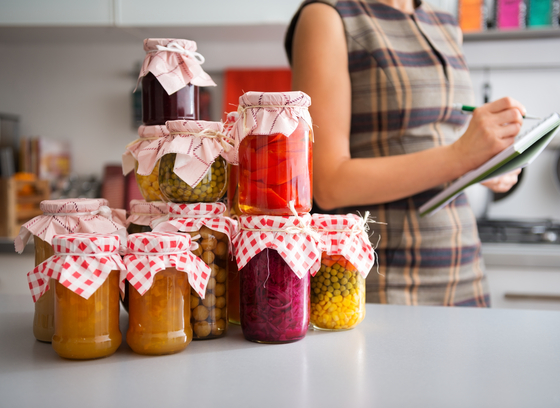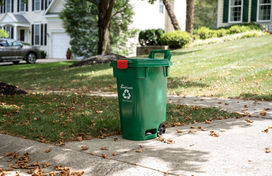Food for Thought
Pledge to start reducing your food waste footprint. Take advantage of these helpful food storage guides, a meal planner apps and donation programs to help limit the amount of food sent to the landfill.

Food Waste Prevention
Grocery Planning
Create a plan and stick to it! The following apps and planners can help save money and prevent unnecessary food waste.
Love Food Hate Waste Portion Planner
Even when we plan ahead, sometimes there's still scraps and leftovers. Check out this Ikea Cookbook for some creative uses for those scraps!
Storage Tips
Maximize the freshness of items in your fridge, freezer and pantry with these storage guides.
American Heart Association Food Storage Guide
Produce Shelf Life & Storage Chart
Save The Food Interactive Storage Guide
Food Labels
Food product dates and labels are not only confusing, but not federally regulated*. Manufacturers provide date labels to help consumers make decisions about a food's quality (not safety). Unfortunately, this has led to an estimated 30% of the food supply being lost or wasted.
Best Before/Best By: The expected date for the best flavor/quality. It is not a safety date.
Sell By: The date for stores to display a product for sale. It is not a safety date.
Use By: The last date recommended for an item's 'peak' quality. It is not a safety date.
When it comes to safety, use your eyes and nose. Your senses are a great way to detect if food is still safe for consumption.
*Exception for infant formula.
Food Donation & Recovery
Donation
Since the Bill Emerson Good Samaritan Food Donation Act of 1996, anyone who makes 'good faith' donations of food is exempt from any liability that may arise. This Act includes donations by school food authorities, higher education institutions, farms, restaurants and all food service companies.
Take advantage of the many local food donation opportunities below.
Recovery
Recovery of surplus food is a necessary step to reduce overall food waste. Many organizations are creating innovative ways to connect kitchens, restaurants, caterers and other food providers with the local community.
Composting
Food is the single largest material type to be landfilled, making it a major contributor to greenhouse gas emissions. Once food is no longer fit for consumption, composting is the next best solution to keep food out of landfills.
Our Feed The Green Bin program provides a weekly curbside food scrap collection service to eligible County residents. County residents can always drop off food scraps at the Residents' Convenience Center at Alpha Ridge Landfill. For those looking to compost at home, backyard compost bins are also available for County residents at no charge.
Sustainable Shopping
Groceries
Reduce & Recycle
Bring Your Own Bag: Reduce your plastic bag usage and bring your own bag when shopping. As of October 1, 2020, all stores in Howard County who provide customers a disposable plastic bag at the point of sale are required to charge 5 cents per bag. Be the Change, Keep the Change.
Bring Your Own Container: Reusable bags aren’t the only thing you should always have on hand. Reduce the amount of disposables by bringing your own water bottle, travel mug and even utensils when dining and carrying out.
Buy in Bulk: Consider buying items in bulk when appropriate to reduce the amount of packaging required.
Shop Smarter, Buy Recyclable: Not all grocery store and carryout packaging is recyclable. Before you shop, make sure the item is recyclable or compostable.
Rethink
Plan Ahead: Nearly 30% of our food is wasted. We can reduce that statistic by planning ahead. Our Food Waste Prevention page has tips on how to create a flexible shopping list, plan out your meals, and store food properly.
Refuse Unnecessary Extras: If you’ve already brought your own, this shouldn’t be difficult! Refuse the plastic bags, utensils, straws, napkins and other single-use “extras.”
Household Products
Reduce & Recycle
Buy it for Life: One way to reduce what we send to the landfill is to choose durable, high quality items whenever possible. A little research before making a purchase can save you and the environment. Check out some of these buying guides for helpful reviews:
Know Before You Throw! Before tossing an item, see what drop-off or mail-in recycling programs are available. If it’s in good condition, consider donating first! Visit our website to search for an item.
Rethink
Borrow Before You Buy: There’s no sense in buying something you may only use once! The DIY Education Center at the Elkridge library is a great resource for tools and equipment available to loan.
Repair Before Replace: Consider attending a Repair Café event. This organization specializes in fixing, repairing and mending everything from lamps to vacuum cleaners to clothing and jewelry.
Used Before New: Save some money (and the environment) and buy used whenever possible. Thrift stores, consignment shops and yard sales are great places to find good quality (used) items. The online marketplace is also full of options:
Shop Sustainably: Supporting local and sustainable companies (Certified B Corporation, 1% for the Planet, etc.) is a great way shop smarter for the planet.
Understanding Ecolabels & Logos
What exactly does it mean when a notebook has the FSC label stamped on it? What's the difference between the universal recycling logo and the How2Recycle logo? Use our chart below to help demystify some of these "ecolabels" and become a more informed shopper.
| 1% For The Planet | |
|---|---|
|
Businesses (or individual members) that give at least 1% of their profits to an approved environmental non-profit. |
Image
 |
| Biodegradable Products Institute (BPI) | |
|
The leading certifier of compostable products in North America. Products and packaging that meet BPI or ASTM D6400 standards are certified compostable and are permitted in our Feed The Green Bin food scrap collection program. |
Image
 |
| Certified B Corporation | |
|
Certified B Corporations are businesses "that meet the highest standards of verified social and environmental performance, public transparency, and legal accountability to balance profit and purpose.” |
Image
 |
| Forest Stewardship Council (FSC) | |
|
FSC’s mission is to “promote environmentally appropriate, socially beneficial, and economically viable management of the world’s forests.”
|
Image
 |
| How2Recycle | |
|
The How2Reycle label was designed to remove the confusion surrounding a product's recyclability. These labels contain instructions on how to correctly recycle, dispose or drop-off packaging depending upon the material type. The program currently has over 225 brandowners and retailers as members and over 75,000 products with a How2Recycle label. |
Image
 |
| Maryland Green Registry | |
|
Maryland businesses, churches, schools, government agencies and other organizations that take steps to reduce their environmental footprint are part of the Maryland Green Registry. |
Image
 |
| Recycling Symbol | |
|
The universal recycling symbol was designed by Gary Anderson in a contest at the first Earth Day event in 1970. The symbol is widely used in many countries and is part of the public domain. A resin identification code system (#1-7) was introduce in the 1980s to assist recyclers with the sorting and processing of plastics. Contrary to popular belief, this system does not indicate whether an item is recyclable. |
Image
 |
| Seal of Testing Assurance (STA Compost) | |
|
The US Composting Council's Seal of Testing Assurance (STA) is a compost testing, labeling and information disclosure program. STA certified compost is held to the highest standards and must be regularly tested to maintain this status. Howard County's HoCoGro Compost is STA certified and recent lab reports are available online. |
Image
 |
| Sustainable Forestry Initiative | |
|
Created to "advance sustainable forestry and responsible purchasing," the Sustainable Forestry Initiative label assures consumers that the fiber in the packaging was sustainably sourced. |
Image
 |
| USDA Organic | |
|
The US Department of Agriculture established a third-party National Organic Program (NOP) that develops "rules and regulations for the production, handling, labeling, and enforcement of all USDA organic products." Companies that mislabel a product as "organic" can be fined up to $17,952 for each violation. |
Image
 |
| Work Green Howard Certified | |
|
Work Green Howard certified businesses are those that report their recycling tonnages to Howard County each year. These businesses often make additional strides to reduce their environmental footprint and may apply for our annual Green Awards. |
Image
 |

